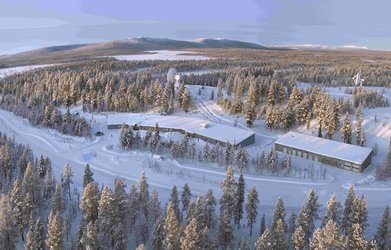CryoSat ready for launch: Media Day at IABG/Munich
ESA PR 21-2009. On Monday 14 September media representatives will have the opportunity to attend an in-depth CryoSat background briefing at IABG’s spacecraft test centre in Ottobrunn near Munich, Germany.
Project managers from ESA and industry, as well as scientists and other experts, will give presentations on the spacecraft and its scientific objectives and will be available for individual interviews. The programme (see below) includes a visit to the cleanroom to see the satellite at first hand before it is packed and shipped to the Baikonur launch base in Kazakhstan.
The European Space Agency’s CryoSat satellite is designed to provide new measurements of the extent and the thickness of the Earth’s polar ice sheets. CryoSat’s innovation is that it will not only be able to map the extent of the ice cover but will also measure the thickness of the ice sheets. This will provide information on ice volume and will therefore further our understanding of the effects climate change is having, and will have, on global ice cover.
After the successful launch in 2002 of Envisat, the largest Earth observation satellite ever built, ESA started to develop the Earth Explorer missions in order to provide a moderate-cost, fast response to important scientific issues using cutting-edge technologies. As the first of these missions, the original CryoSat was launched in 2005, but the launch resulted in failure with the remains of the satellite crashing down near the North Pole shortly after lift-off. Following the successful launch of ESA’s gravity mission GOCE on 17 March of this year and the upcoming launch of ESA’s water mission SMOS in November, the CryoSat mission will finally get off the ground with the spacecraft rebuilt by prime contractor Astrium, becoming ESA’s third Earth Explorer in orbit.
Scheduled for launch this December aboard a Dnepr launcher from Baikonur in Kazakhstan, CryoSat is set to significantly improve our knowledge of global ice mass. The mission will enhance our understanding of how the polar regions are influenced by climate change as well as our knowledge of the interaction between sea ice and the oceans. It may also trigger a number of practical applications, such as improved understanding of ocean circulation and greater insights into current and future changes in sea level.
Programme
The programme for the Media Day on 14 September at IABG will run as follows:
10:30 – 11:00 Registration
11:00 – 11:05 Welcome to IABG, Stefan Kupczyk, Head of Space Division, IABG
11:05 – 11:20 Welcome and Introduction to ESA’s Earth Observation Programme and the Earth Explorer Missions, Volker Liebig, Director of ESA Earth Observation Programmes
11:20 – 11:30 The CryoSat Mission, Richard Francis, CryoSat Project Manager, ESA
11:30 – 11:40 Engineering of the Spacecraft, Eckard Settelmeyer, Director EO & Science, Astrium
11:40 – 11:50 The CryoSat Radar Altimeter Instrument, Laurent Rey, SIRAL Instrument Project Manager, Thales Alenia Space
11:50 – 12:10 Scientific Challenges and Expected Results from the CryoSat Mission, Duncan Wingham, University College London, CryoSat Lead Investigator
12:20 – 12:45 Q&A session
12:45 – 13:45 Visit to see the CryoSat satellite; photo and interview opportunities in the clean room
13:45 – 14:45 Working lunch with additional interview opportunities
14:45 End of event
Media representatives wishing to attend this event are kindly requested to fill in the attached registration form and email or fax it back by Thursday 10 September to:
IABG mbH
Corporate Communications
Monika Amler
Tel. +49 (0) 89 6088-2030
Fax. +49 (0) 89 6088-4000
presse@iabg.de
For more information:
Franco Bonacina
ESA Media Relations Office
Communication and Knowledge Department
Tel. +33 1 53 69 77 13
media@esa.int















 Germany
Germany
 Austria
Austria
 Belgium
Belgium
 Denmark
Denmark
 Spain
Spain
 Estonia
Estonia
 Finland
Finland
 France
France
 Greece
Greece
 Hungary
Hungary
 Ireland
Ireland
 Italy
Italy
 Luxembourg
Luxembourg
 Norway
Norway
 The Netherlands
The Netherlands
 Poland
Poland
 Portugal
Portugal
 Czechia
Czechia
 Romania
Romania
 United Kingdom
United Kingdom
 Slovenia
Slovenia
 Sweden
Sweden
 Switzerland
Switzerland




























